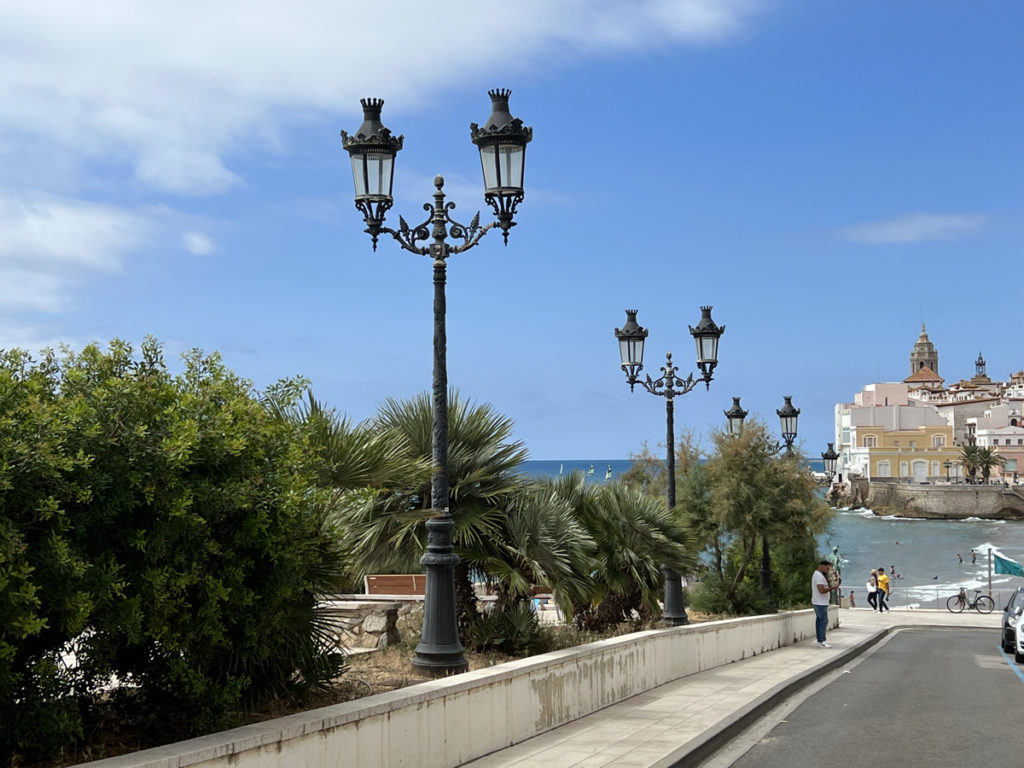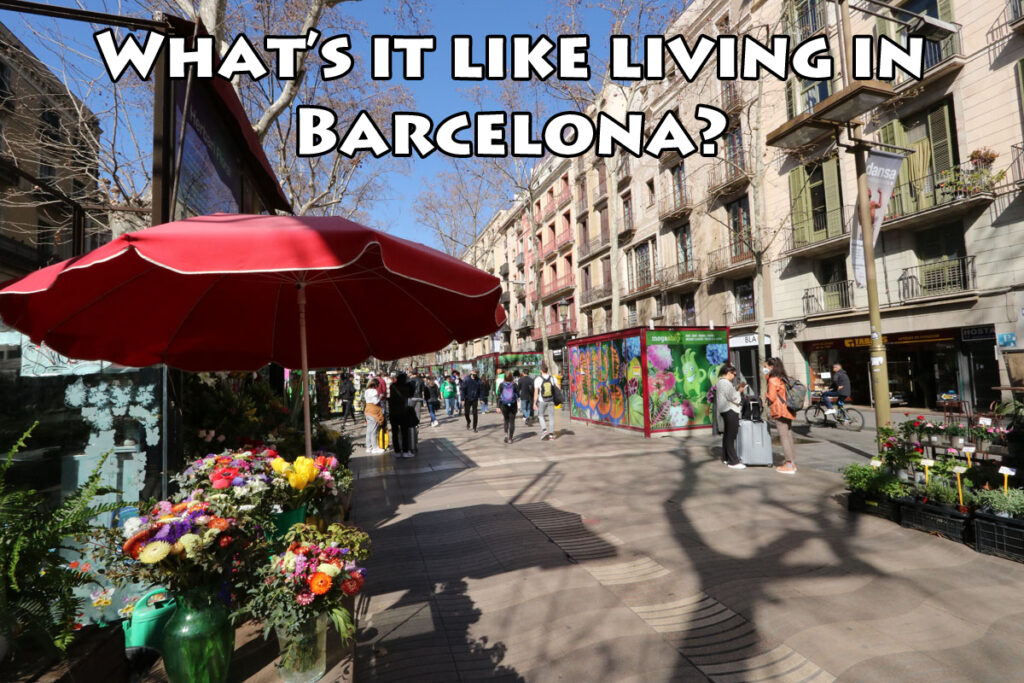What’s it like living in Sitges?
Marie-Noëlle is a long-term expat who lived all over the world before deciding to make Spain home.
In this interview she tells us all about her life in Sitges, a beautiful place made even more beautiful by her photos (among other things, Marie-Noëlle is a photographer. All the photos below are hers).

Name: Marie-Noëlle Crabbé
Age: 62
Country of Origin: Belgium
Number of years in Spain: 7
Hi Marie-Noelle! Can you please tell me about yourself and on how you ended up moving to Spain?
Hello. Although my family is originally from Brussels, I never lived in Belgium. As a child, we were long-term ‘expats’ living abroad in Mexico and France, which taught me to become a chameleon and adjust to any context. As an adult, I lived in France, Mexico, Boston and spent extensive time in Peru before moving to Barcelona, Spain.


A few useful Resources
Private health insurance in Spain. We recommend Innoinsure, they make it easy. And you don’t need a Spanish bank account – you can pay with foreign credit cards. More info here.
Spartan FX. Buying a house or car in Spain and need to transfer and exchange a large sum of money? More here.
Wise. For everyday transfers and exchanges of money from your home country. Nobody should be using banks anymore. More here.
Why Barcelona?
After my three sons left the house, I moved to Europe thanks to my Belgian citizenship which allowed me to choose residence in any of the 27 countries of the European Union. Barcelona was my city of choice because of its history, location, beauty, and palm trees replacing the snowbanks of the Boston area. I settled in Barcelona in 2015, bought an apartment in Poblenou neighborhood, close to the beach and its beautiful Rambla, and a ride away from Plaza Catalunya. One important consideration about Barcelona is its reliable health system and good hospital network. As a member of the EU, I have access to the Spanish health system for free, and can see a doctor at the local CAP (medical clinic available in all neighborhood). An additional payment (about 100€/month per person) gives access to a private insurance that opens the doors to private hospitals, health specialists, ophthalmologists, dentists, with 100% coverage. This insurance also provides coverage when traveling abroad.
So how did you come across Sitges?
In my early 20s, I discovered Sitges and its great night-life for teens and young adults. For five years, I spent summers and vacations in Sitges that left lasting memories. I always thought Sitges would be a lovely place to live… someday! The soccer world cup (1982) and the Olympic games (1992) propelled Sitges to stardom because of its beauty, proximity to Barcelona, and acceptance of all sexual orientations. A nice opportunity came up early 2022 through a friend who called when an apartment became available in her building. My dream of living in Sitges suddenly became reality: the unit faces Balmins’ beach, north of Playa San Sebastian.
The proximity to Sitges’ train station from the flat allows an easy ride downtown: it takes about 40 minutes to reach Barcelona Sants station, and 45 minutes to Paseo de Gracia, which is very central. There is also a bus to/from Barcelona’s plaza Universidad that takes you to Sitges and the neighboring villages, Sant Pere de Ribes, Vilanova, etc. The car alternative is pricy because of tolls (unless you take the road along the seashore) and parking in the city. Also, keep in mind that rush-hour traffic is terrible, as in any big city.

Can you describe Sitges Marie-Noelle?
Sitges is forty kilometers south of Barcelona. It is located between the natural Parque del Garraf and the Mediterranean Sea (there are incredible hiking opportunities along the coast and in the Garraf natural park). This coastal town has kept its original charm thanks to a very involved local population, and numerous celebrations are organized year-round. Most streets in the center are pedestrian with cafe terraces, shops, delis, and restaurants. Sitges’ population is about 29,000 people year-round, and four times this number during the summer months. 35% of Sitges population is foreign, mostly from northern Europe. The beautiful Paseo Marítimo is about 3 kilometers long, and the town has 17 beaches, which makes it a favorite among Barcelona crowds, who come by car, bus or train on weekends. Vacationers who choose Sitges as their destination come from around the world, as it is only 20 minutes south of El Prat airport.
Sitges became popular in the 1960s, and started being noticed by foreigners. Over the years, Sitges has become a favorite among gay communities, although there is a mixed population including lots of families with young kids. It is a good example of coexistence among different populations, origins, and ways of life. However, due to its proximity to Barcelona and its global reputation, Sitges is one of the most expensive towns to live in Spain: its real estate tends to match prices in Barcelona and it is hard to find rentals. A year ago, while looking for a place myself, a real estate agent told me there were 100 requests for one rental. So, be patient if you wish to move here: it is feasible with time and well worth the effort!

What do you do to keep busy? What’s your daily life like?
My move to Barcelona was made possible by a permanent position with a German employer: remote work was already in fashion in my field of work in 2015, and I was able to settle in Barcelona even though my employer was in Cologne, Germany. I worked for many years in the field of social responsibility, more specifically doing social audits for large corporations. This position entailed a lot of traveling and the work stopped abruptly during the pandemic. I then switched to humanitarian work and now use my skills in psychology to assist different non-profit organizations in Barcelona, France and Peru.
During the pandemic I wrote a book about social responsibility auditing called Journal of a social auditor, published in English, French and Spanish.
Most recently, I wrote a second book: Social responsibility at the center of ESG. The manuscript has been submitted to English-speaking publishing houses.
For further information check my website.

You mentioned above that real estate is an issue in Sitges. Are you renting or have you bought a house? How was your experience finding a home? (did you use a broker or do it yourself?)
Rentals usually come with a one to five-year contract: in my case, there was no broker involved because a common friend introduced me to the owners. However, rentals are mostly advertised through agencies for security reasons*, and I went through a realtor to rent my flat in Barcelona. Lodging tends to be pricy in Sitges and most people with a legal right to rent to tourists choose the lucrative short-term rental option instead of long-term contracts.
*There is a rental issue in Spain called ‘ocupas’, when people rent an apartment, change the locks and stop paying their rents. Ocupas (ie. squatting) stories terrorize people wishing to rent property because it is hard to evict families with kids.

Do you have any other tips/advice for anyone considering Sitges as a possible place to live?
People wishing to live in Sitges need to plan ahead and be patient. Nice places abound and come up for rent, but it is a question of patience and… luck. Before buying property in or around Sitges, it is recommended to hire a financial advisor because real-estate is a tricky business in Spain. There is no MLS like in the US, a platform where all sales and rentals are published (sorry, not aware of the British equivalent). Here, several agencies may advertise the same property for sale at different prices; this does not usually happen for rentals, but this country is full of surprises…

Are there any other negatives (apart from high real estate) about Sitges?
Sitges is very busy on weekends year-round, on holidays and during summer vacations. It is easily accessible and its public beaches are beautiful and well-kept. The town is attractive and its townhall organizes events and activities year-round, if not every weekend. When you visit Sitges, be open-minded and prepare to come across people from all venues and nationalities. It is a busy place with some eccentric sides… One needs to be aware that administrative processes are often painfully slow around here: This is the Mediterranean region where things are organized differently and don’t follow the same pace: it is good to keep in mind that Catalunya is located in southern Europe and Sitges still has the mind of a big village.
Note for those willing to move to Catalunya: Working in Spain does not necessarily mean working for locals with a 950€/month minimum wage. There are plenty of international companies with offices in Barcelona, and I know of expats whose companies are in their home countries and who work remotely from Sitges.
For those looking to expand their career opportunities, there’s a wealth of Europe vacancies abroad tailored to various skills and ambitions.

If you didn’t live in Sitges, where would you live Marie-Noelle?
If you cannot afford Sitges, my recommendation is to look for a place in Vilanova (south), Sant Pere de Ribes (west), or more inland. The weather is particularly agreeable in this region because it is protected from most winds, and the pollution that affects Barcelona does not reach us. Catalan is preferred and knowing Spanish is highly recommended. From my brief experience in Sitges, it is hard to envision living anywhere else!

Where do you see yourself in the future? Do you think you will always be in Spain?
I travel to Belgium every month to care for an elder parent and Sitges is a good compromise. Now that the professional life is no longer a priority, my life is pleasant in this small town with the pace of a village close to a large city. Family and friends easily visit Sitges by train, plane or road. The airport is 20 minutes away and offers connections around the world. I conclude with a thought about this country seven years on: it is a privilege to live by the Mediterranean Sea and enjoy its beauty every day. The climate is so pleasant that people live outside year-round, and socialize. During the winter months, some terraces are still open and tourists are replaced by locals in a calmer atmosphere. Sitges offers the beautiful life of a small town where everything is walking distance. Barcelona is close, and a hop in the train brings me to an endless options of activities. Every morning, my walk starts at playa San Sebastian. I would not change this for anything.

Thank you for doing this interview Marie-Noelle!
Related: What’s it like living in Barcelona?

Related: What makes Valencia a great place to live in Spain?

Related: What’s it like living in the city of Málaga?


Leave a Reply